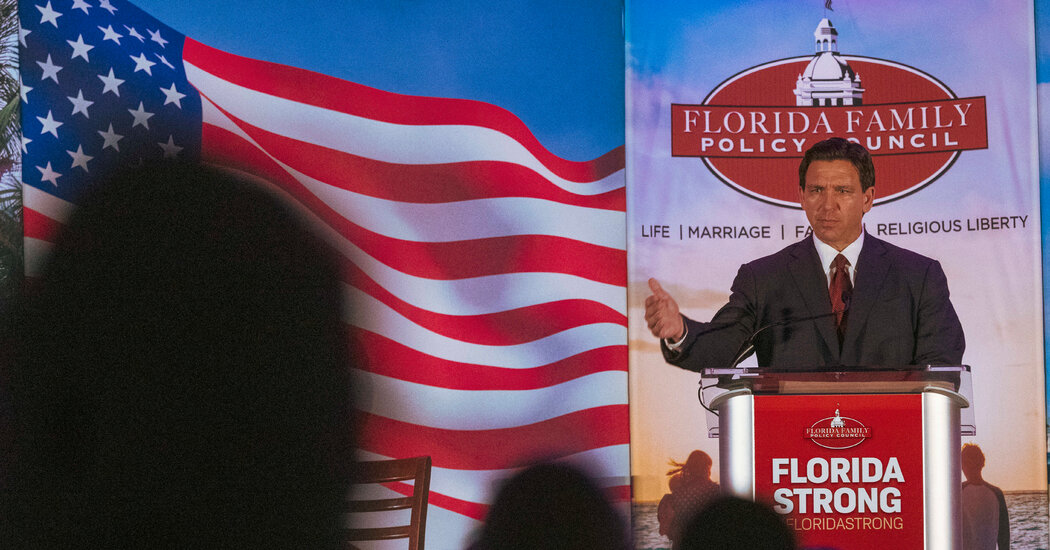Within hours of Florida Governor Ron DeSantis announcing his presidential run on Twitter on Wednesday, attendees at the audio event were celebrating the achievement.
David Sacks, a venture capitalist who moderated the Twitter conversation, declared it “by far the largest room ever held on social media.” After the event, Mr. DeSantis, a Republican, said in a podcast interview that he believed later that day “probably more than 10 million people” would have “viewed” the event, called a Twitter Space, or a recording of it.
They were wrong on both counts.
According to Twitter statistics, the audio event — which was initially marred by more than 20 minutes of technical glitches before being rebooted — drew a peak of about 300,000 simultaneous listeners, or those who tuned in at the same time as Mr. DeSantis made his announcement. According to figures from Twitter, a total of 3.4 million people had listened to the Space or a recording of it on Thursday.
Those numbers didn’t reach 10 million people, nor were they “the largest social media space” compared to previous live streams.
Recall that a Facebook Live event in 2016 in which two BuzzFeed employees placed rubber bands around a watermelon until it exploded attracted more than 800,000 simultaneous viewers and a total of five million views within hours of its conclusion. The live stream of a pregnant giraffe in 2017 on YouTube attracted five million viewers a day.
In fact, the event with Mr. DeSantis was overshadowed by previous audio live streams on Twitter. More than last month three million people were listening simultaneously at one point to an interview of Elon Musk, the owner of Twitter, by a BBC reporter in a Twitter Space, according to the company’s figures. a recording of that space said 2.6 million listeners eventually “tuned in”. (Twitter has not explained the discrepancy between the number of concurrent listeners and the “aligned” figure.)
“Getting a few hundred thousand people to do something for a few minutes isn’t that big of a deal,” said Brian Wieser, a veteran media analyst who heads the strategic consulting firm Madison and Wall. “I’m not entirely sure that using Twitter to announce a presidential campaign was the most impactful environment, although maybe Twitter could become that.”
Determining the reach and audience for Mr. DeSantis’ Twitter announcement is important because the online event was heralded as a modern way of making political proclamations, bypassing traditional media such as cable news and network television. Still, Twitter’s initial numbers raise the question of whether a presidential candidate can ignore traditional media for their big campaign announcements.
While television generally doesn’t attract the same numbers as it did a decade ago, some live political events still draw large audiences. For example, when President Biden gave his State of the Union address on Feb. 7, the speech was broadcast live to 27.3 million viewers on 16 TV channels, according to Nielsen.
Representatives for Mr. DeSantis, who followed his Twitter Space by appearing on Fox News, did not immediately respond to a request for comment. Mr. Sacks and Mr. Musk also did not immediately respond to email inquiries.
That’s not to say that using social media to make political announcements can’t be powerful. Mr Wieser said that with so much media fragmentation there was no unifying platform and the quality of the audience was often a motivating factor for politicians. Perhaps, he said, Mr. DeSantis’ goal was not to reach the most people, but to reach those who would be most convinced to donate to him or help spread his message.
Comparing the reach of social media to television broadcasts can also be difficult. A “unique” social media view represents each individual account that visits a post or other content, rather than the number of times it is visited. Such views don’t necessarily come from humans as bot activity may be involved, and don’t indicate whether a viewer tuned in for half a second or half an hour. TV viewing figures, on the other hand, represent the average number of viewers over a longer period of time, Mr Wieser said.
Twitter also doesn’t explain the difference between how it counts listeners on its live streams and those who listened to recordings from Twitter Spaces.
“The reach on Twitter is artificial. People are more likely to tune in and watch faster. They’re probably watching on a mobile device that just isn’t as effective at getting people’s attention as a big TV set,” said Ross Benes, a senior analyst with Insider Intelligence covering digital video, TV and streaming.
Following the close of the Twitter Space on Wednesday with Mr. DeSantis, traditional media outlets mocked the event’s technical issues. When Mr. DeSantis appeared on Fox News, Trey Gowdy, the host, joked, “Fox News won’t crash on this interview.” The segment attracted nearly two million viewers.
On Thursday, Mr. DeSantis also tried to make light of the Twitter Space’s technical issues. His campaign sent out fundraising emails and displayed T-shirts stating that the presidential candidate had “broken the internet”.
Nicholas Nehamas And John Koblin reporting contributed.

